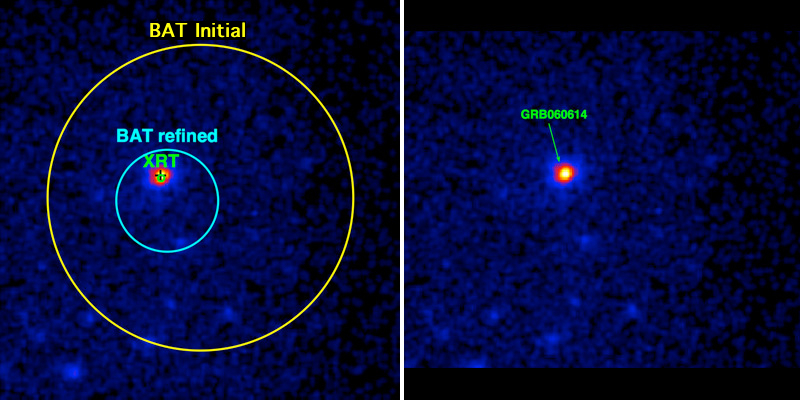
 Credit:NASA/Swift Team
Credit:NASA/Swift Team
The Long and the Short of It
Gamma-Ray bursts, the extreme explosions that mark the birth of black holes, come in two flavors, long bursts lasting a few seconds or more, and short bursts lasting for less than a second. The mechanisms giving rise to these two types of bursts were, for a long time, unknown to astronomers. But a series of breakthroughs starting with BeppoSAX, HETE, and Swift gave astronomers some clues and confidence about the nature of long and short bursts. Long bursts mark the collapse of a young, extremely massive star into a black hole; short bursts mark the formation of a black hole by a merger of neutron stars (or perhaps a neutron star with a black hole to form a larger black hole). But a new observation has clouded this clear dichotomy. The picture above is an X-ray image of a gamma-ray burst, GRB 060614, taken by Swift's X-ray Telescope. This burst lasted more than 100 seconds, clearly showing that it's a long burst. But follow-up observations of the burst did not show the tell-tale signatures of a supernova explosion which should be produced by the collapse of a large star. Furthermore this burst occurred in a galaxy which has very few extremely massive stars. Does this hybrid burst represent an entirely new mechanism behind these titanic explosions? The hunt is on.
<
HEA Dictionary ● Archive
● Search HEAPOW
● Other Languages
● HEAPOW on Facebook
● Download all Images
● Education ● HEAD
>
Each week the HEASARC
brings you new, exciting and beautiful images from X-ray and Gamma-ray
astronomy. Check back each week and be sure to check out the HEAPOW archive!
Page Author: Dr. Michael F. Corcoran
Last modified Tuesday, 27-Feb-2024 10:15:14 EST


